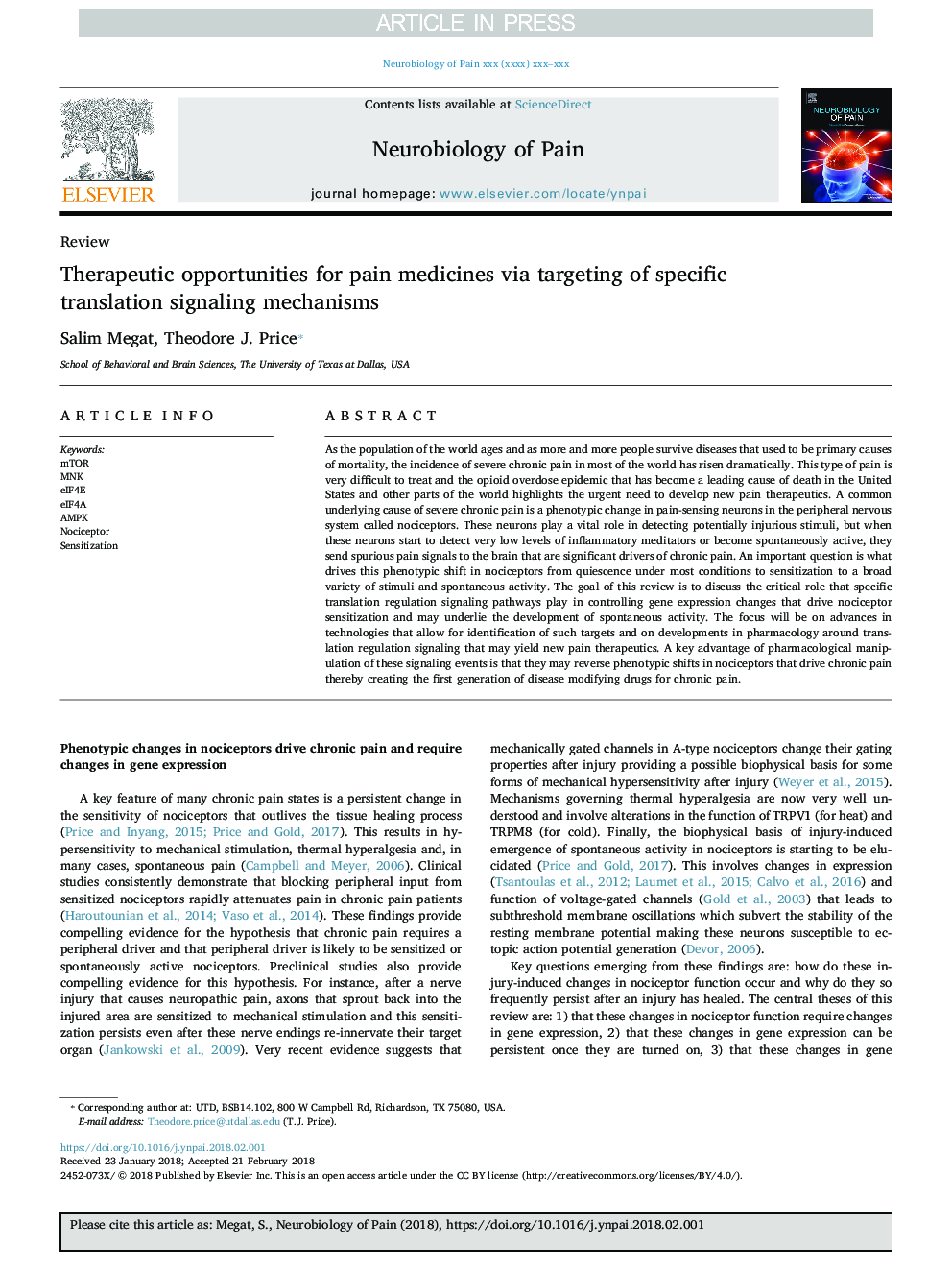| کد مقاله | کد نشریه | سال انتشار | مقاله انگلیسی | نسخه تمام متن |
|---|---|---|---|---|
| 8966230 | 1646791 | 2018 | 12 صفحه PDF | دانلود رایگان |
عنوان انگلیسی مقاله ISI
Therapeutic opportunities for pain medicines via targeting of specific translation signaling mechanisms
ترجمه فارسی عنوان
فرصت های درمانی برای داروهای درد با هدف قرار دادن مکانیزم های سیگنال انتقال خاص
دانلود مقاله + سفارش ترجمه
دانلود مقاله ISI انگلیسی
رایگان برای ایرانیان
ترجمه چکیده
به عنوان جمعیت جهان در طول سنین و به عنوان بیشتر و بیشتر مردم زنده ماندن از بیماری هایی که به عنوان اصلی ترین علت مرگ و میر، بروز درد شدید مزمن در بسیاری از جهان به طور چشمگیری افزایش یافته است. این نوع درد برای درمان بسیار دشوار است و اپیدمی شدن بیش از حد مواد مخدر که یکی از علل اصلی مرگ در ایالات متحده و سایر نقاط جهان است، ضروری به نیاز به درمان های جدید درد است. یک علت رایج در زمینه درد شدید مزمن، یک تغییر فنوتیپی در نورونهای حساس به درد در سیستم عصبی محیطی به نام نوکسیپتورها است. این نورون ها نقش مهمی در تشخیص انگیزه های بالقوه آسیب زا بازی می کنند، اما وقتی این نورون ها شروع به تشخیص سطح بسیار پایین مدیتیشن های التهابی می کنند یا به طور خود به خود فعال می شوند، سیگنال های درد مزمن را به مغز می رسانند که راننده های مهم درد مزمن هستند. یک سوال مهمی است که این تغییر فنوتیپی در افراد مبتلا به خستگی ناپذیر از خلوص در بیشتر شرایط به حساسیت به انواع مختلفی از محرک ها و فعالیت های خود به خودی است. هدف این بررسی، بحث درباره نقش حیاتی است که مسیرهای سیگنالینگ تنظیم مقررات خاص در کنترل تغییرات بیان ژن نقش دارند که حساسیت ناخوشایند را مهار می کنند و می توانند فعالیت خود به خودی را تحت تأثیر قرار دهند. تمرکز بر پیشرفت فن آوری هایی است که به شناسایی چنین اهدافی و تحولات در فارماکولوژی در اطراف تنظیمات ترجمه اشاره می کند که ممکن است درمان های جدید درد را به وجود آورد. مزیت کلیدی دستکاری فارماکولوژیکی این حوادث سیگنالینگ این است که آنها ممکن است تغییرات فنوتیپی را در نقص های غیر عادی که باعث درد مزمن می شوند را تغییر دهند و نسل اول داروهای اصلاح کننده بیماری را برای درد مزمن ایجاد کنند.
موضوعات مرتبط
علوم زیستی و بیوفناوری
علم عصب شناسی
علوم اعصاب (عمومی)
چکیده انگلیسی
As the population of the world ages and as more and more people survive diseases that used to be primary causes of mortality, the incidence of severe chronic pain in most of the world has risen dramatically. This type of pain is very difficult to treat and the opioid overdose epidemic that has become a leading cause of death in the United States and other parts of the world highlights the urgent need to develop new pain therapeutics. A common underlying cause of severe chronic pain is a phenotypic change in pain-sensing neurons in the peripheral nervous system called nociceptors. These neurons play a vital role in detecting potentially injurious stimuli, but when these neurons start to detect very low levels of inflammatory meditators or become spontaneously active, they send spurious pain signals to the brain that are significant drivers of chronic pain. An important question is what drives this phenotypic shift in nociceptors from quiescence under most conditions to sensitization to a broad variety of stimuli and spontaneous activity. The goal of this review is to discuss the critical role that specific translation regulation signaling pathways play in controlling gene expression changes that drive nociceptor sensitization and may underlie the development of spontaneous activity. The focus will be on advances in technologies that allow for identification of such targets and on developments in pharmacology around translation regulation signaling that may yield new pain therapeutics. A key advantage of pharmacological manipulation of these signaling events is that they may reverse phenotypic shifts in nociceptors that drive chronic pain thereby creating the first generation of disease modifying drugs for chronic pain.
ناشر
Database: Elsevier - ScienceDirect (ساینس دایرکت)
Journal: Neurobiology of Pain - Volume 4, AugustâDecember 2018, Pages 8-19
Journal: Neurobiology of Pain - Volume 4, AugustâDecember 2018, Pages 8-19
نویسندگان
Salim Megat, Theodore J. Price,
